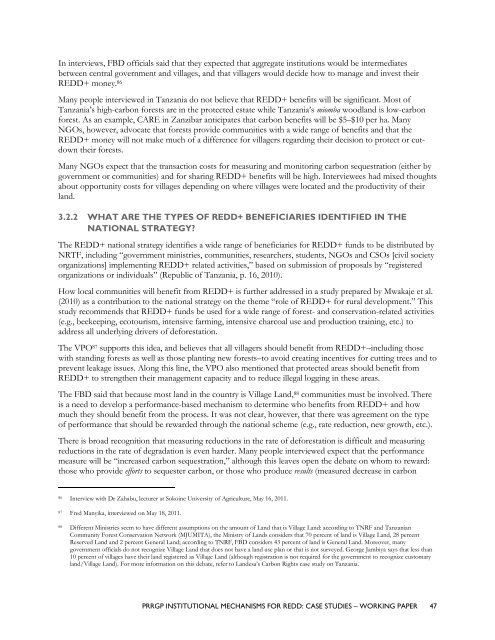Institutional Mechanisms for REDD+ - Case Studies Working Paper
Institutional Mechanisms for REDD+ - Case Studies Working Paper
Institutional Mechanisms for REDD+ - Case Studies Working Paper
Create successful ePaper yourself
Turn your PDF publications into a flip-book with our unique Google optimized e-Paper software.
In interviews, FBD officials said that they expected that aggregate institutions would be intermediates<br />
between central government and villages, and that villagers would decide how to manage and invest their<br />
<strong>REDD+</strong> money. 86<br />
Many people interviewed in Tanzania do not believe that <strong>REDD+</strong> benefits will be significant. Most of<br />
Tanzania‘s high-carbon <strong>for</strong>ests are in the protected estate while Tanzania‘s miomba woodland is low-carbon<br />
<strong>for</strong>est. As an example, CARE in Zanzibar anticipates that carbon benefits will be $5–$10 per ha. Many<br />
NGOs, however, advocate that <strong>for</strong>ests provide communities with a wide range of benefits and that the<br />
<strong>REDD+</strong> money will not make much of a difference <strong>for</strong> villagers regarding their decision to protect or cutdown<br />
their <strong>for</strong>ests.<br />
Many NGOs expect that the transaction costs <strong>for</strong> measuring and monitoring carbon sequestration (either by<br />
government or communities) and <strong>for</strong> sharing <strong>REDD+</strong> benefits will be high. Interviewees had mixed thoughts<br />
about opportunity costs <strong>for</strong> villages depending on where villages were located and the productivity of their<br />
land.<br />
3.2.2 WHAT ARE THE TYPES OF <strong>REDD+</strong> BENEFICIARIES IDENTIFIED IN THE<br />
NATIONAL STRATEGY?<br />
The <strong>REDD+</strong> national strategy identifies a wide range of beneficiaries <strong>for</strong> <strong>REDD+</strong> funds to be distributed by<br />
NRTF, including ―government ministries, communities, researchers, students, NGOs and CSOs [civil society<br />
organizations] implementing <strong>REDD+</strong> related activities,‖ based on submission of proposals by ―registered<br />
organizations or individuals‖ (Republic of Tanzania, p. 16, 2010).<br />
How local communities will benefit from <strong>REDD+</strong> is further addressed in a study prepared by Mwakaje et al.<br />
(2010) as a contribution to the national strategy on the theme ―role of <strong>REDD+</strong> <strong>for</strong> rural development.‖ This<br />
study recommends that <strong>REDD+</strong> funds be used <strong>for</strong> a wide range of <strong>for</strong>est- and conservation-related activities<br />
(e.g., beekeeping, ecotourism, intensive farming, intensive charcoal use and production training, etc.) to<br />
address all underlying drivers of de<strong>for</strong>estation.<br />
The VPO 87 supports this idea, and believes that all villagers should benefit from <strong>REDD+</strong>–including those<br />
with standing <strong>for</strong>ests as well as those planting new <strong>for</strong>ests–to avoid creating incentives <strong>for</strong> cutting trees and to<br />
prevent leakage issues. Along this line, the VPO also mentioned that protected areas should benefit from<br />
<strong>REDD+</strong> to strengthen their management capacity and to reduce illegal logging in these areas.<br />
The FBD said that because most land in the country is Village Land, 88 communities must be involved. There<br />
is a need to develop a per<strong>for</strong>mance-based mechanism to determine who benefits from <strong>REDD+</strong> and how<br />
much they should benefit from the process. It was not clear, however, that there was agreement on the type<br />
of per<strong>for</strong>mance that should be rewarded through the national scheme (e.g., rate reduction, new growth, etc.).<br />
There is broad recognition that measuring reductions in the rate of de<strong>for</strong>estation is difficult and measuring<br />
reductions in the rate of degradation is even harder. Many people interviewed expect that the per<strong>for</strong>mance<br />
measure will be ―increased carbon sequestration,‖ although this leaves open the debate on whom to reward:<br />
those who provide ef<strong>for</strong>ts to sequester carbon, or those who produce results (measured decrease in carbon<br />
86 Interview with Dr Zahabu, lecturer at Sokoine University of Agriculture, May 16, 2011.<br />
87 Fred Manyika, interviewed on May 18, 2011.<br />
88 Different Ministries seem to have different assumptions on the amount of Land that is Village Land: according to TNRF and Tanzanian<br />
Community Forest Conservation Network (MJUMITA), the Ministry of Lands considers that 70 percent of land is Village Land, 28 percent<br />
Reserved Land and 2 percent General Land; according to TNRF, FBD considers 43 percent of land is General Land. Moreover, many<br />
government officials do not recognize Village Land that does not have a land use plan or that is not surveyed. George Jambiya says that less than<br />
10 percent of villages have their land registered as Village Land (although registration is not required <strong>for</strong> the government to recognize customary<br />
land/Village Land). For more in<strong>for</strong>mation on this debate, refer to Landesa‘s Carbon Rights case study on Tanzania.<br />
PRRGP INSTITUTIONAL MECHANISMS FOR REDD: CASE STUDIES – WORKING PAPER 47

















